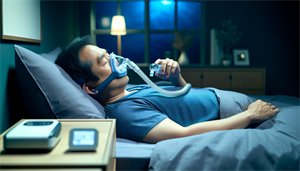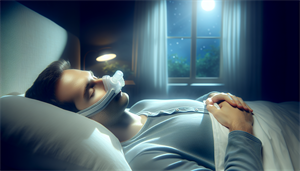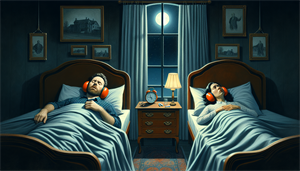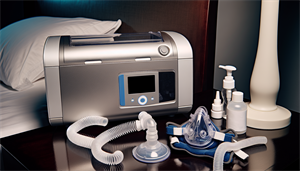Snoring and sleep apnea can be more than just a nighttime nuisance - they can have serious effects on health and quality of life. But what if there was a device that could help alleviate these problems in a less invasive and more comfortable way?
Enter the anti snore micro cpap, a small, maskless device designed to combat snoring and sleep apnea. But how effective are these devices really, and are they a viable alternative to traditional solutions?
In this blog post, we’ll dive into the fascinating world of anti snore micro cpaps and evaluate their potential as a snoring and sleep apnea solution.
Key Takeaways
-
Micro CPAP devices are an emerging technology designed to treat sleep apnea without a mask or hose, but their efficacy and safety have yet to be clinically proven and FDA approved.
-
Traditional CPAP machines remain the preferred treatment for sleep apnea due to proven effectiveness, while micro CPAP devices face regulatory challenges and lack sufficient evidence of their air pressure capabilities and overall performance.
-
Potential micro CPAP device users should consider the current lack of clinical evidence, safety concerns due to non-FDA approval, and alternative treatment options including lifestyle changes and other medical devices.
Unveiling the Micro CPAP: A Snoring Solution?
![]()
Micro CPAP devices offer a new perspective on the time-tested continuous positive airway pressure (CPAP) machines that treat sleep apnea. These compact, mask-free gadgets, known as micro CPAP machines, are engineered with the goal of being less cumbersome and quieter than traditional models, with the aim of minimizing snoring and enhancing sleep quality. Nonetheless, keep in mind that the development of micro CPAP technology is ongoing.
Although these devices show potential, additional studies and clinical tests are needed to definitively confirm their efficacy in treating obstructive sleep apnea.
The Design and Appeal of Micro CPAP Devices
One of the main selling points of micro CPAP devices is their compact, unobtrusive design. Unlike traditional CPAP machines, which require a mask and are often connected to a machine via a hose, micro CPAPs:
-
are lightweight
-
are worn under the nose using nose buds
-
operate through hundreds of micro-blowers that open and close to establish a continuous flow of air, ensuring an open airway during sleep.
However, doubts exist about their capacity to sustain sufficient battery power for a full night’s sleep and the lack of humidity regulation, which could result in dry nasal passages.
Can Micro CPAP Devices Replace Traditional CPAP Machines?
The debate over whether micro CPAP devices can supersede traditional CPAP machines remains unresolved. Presently, due to various constraints, it appears impracticable for micro CPAPs to substitute traditional CPAP machines or other sleep apnea treatments. Moreover, micro CPAP technology is still nascent, with a working micro CPAP prototype still under development. Uncertainties about their effectiveness and safety linger until these devices undergo comprehensive testing and secure approval from authorities like the Food and Drug Administration (FDA).
The Science Behind Micro CPAP Effectiveness

The scientific basis for micro CPAP devices is still a work in progress. Although the idea of employing micro-blowers to create a steady air stream is hopeful, doubts persist regarding the air pressure capacity of these devices. Without adequate clinical trials, evaluating their performance relative to traditional CPAP machines becomes challenging.
Also, significant features like pressure relief or pressure ramp options, ordinarily found in traditional CPAP machines, might be absent in early versions of micro CPAP devices.
Air Pressure Capabilities of Micro CPAPs
While micro CPAP devices are engineered to produce positive airway pressure for sleep apnea treatment, their true abilities remain somewhat vague. The latest updates from manufacturers indicate that micro-blowers in micro CPAP devices can generate air at a pressure of 5 cm H2O, which is below the necessary level for market availability. This ambiguity leads to queries about their capacity to reach the recommended pressure settings typically set between 8 and 10 cm H2O for CPAP users.
Clinical Evidence Supporting Micro CPAP Use
The absence of clinical proof presents a considerable obstacle to the recognition and broad use of micro CPAP devices. Without clinical studies and peer-reviewed research, verifying the claims of reduced snoring and less sleep disturbances is tough. Hence, despite positive experiences reported by some users, bear in mind that these devices lack FDA approval for sleep apnea treatment, and their effectiveness is still questionable.
Comparing Micro CPAP to Conventional Sleep Apnea Treatments
When evaluating micro CPAP devices, it’s imperative to contrast them with standard sleep apnea treatments. Currently, traditional CPAP machines are the preferred method for sleep apnea treatment, having demonstrated efficacy in a broad spectrum of patients. However, due to their bulky and noisy nature, some patients are driven to seek other options.
Though micro CPAP devices present an innovative solution with their small and silent design, the technology is still maturing, and their efficacy remains unproven.
Traditional CPAP vs. Micro CPAP Technology
While the efficacy of traditional CPAP machines has been proven over time, micro CPAP technology remains nascent. A traditional cpap machine depends on a mask linked to an electric device via tubes to provide continuous positive airway pressure, while micro CPAPs strive to accomplish the same result without the necessity for a mask or a separate cpap machine.
However, given the absence of clinical proof and FDA approval, the efficacy of micro CPAP devices remains undefined.
Lifestyle Changes and Other OSA Treatment Plans
Beyond medical devices like CPAP machines, lifestyle adjustments can also significantly contribute to managing obstructive sleep apnea. Such changes can encompass:
-
Weight loss
-
More physical activity
-
Quitting smoking
-
Abstaining from alcohol
Also, consider alternative treatments such as BiPAP, oral appliance therapy, or surgery. Consult with a healthcare provider about these options to determine the most suitable treatment plan.
User Experiences with Anti Snore Micro CPAPs

User experiences with micro CPAP devices can offer useful perspectives on their practical effectiveness and constraints. Reports of reduced snoring and less sleep disturbances from some users hint at the possibility that these devices could enhance sleep quality.
However, some users have noted problems and limitations, including:
-
Discomfort from dry mouth or nasal passages
-
Difficulty falling asleep due to the hose and mask setup
-
A possible reliance on the nasal passage for air humidification.
Real-World Outcomes: Decreased Snoring and Fewer Sleep Disruptions
While some users have reported positive results with micro CPAP devices, these findings are not uniform among all users. Reports of reduced snoring and less sleep disturbances from some users imply a certain degree of effectiveness with these devices. Yet, without adequate clinical tests and validation, determining the frequency of these positive results and if they can be consistently expected from using these devices is challenging.
Challenges and Limitations Reported by Users
Despite the positive experiences reported by some users, there are also accounts of problems and limitations related to micro CPAP devices. Users have reported discomfort from dry mouth and nasal passages, difficulties falling asleep due to the hose and mask setup, and a limited device lifespan.
These issues highlight the need for further development and refinement of micro CPAP devices to improve user comfort and satisfaction.
FDA Approval Status and Safety Considerations
Before contemplating the use of micro CPAP devices, one should be cognizant of their FDA approval status and safety considerations. At present, these devices have not secured FDA approval, and their safety and efficacy have not been thoroughly confirmed through clinical trials. Consequently, although they may present a novel approach to treating snoring and sleep apnea, their use should be approached cautiously.
Regulatory Hurdles for Micro CPAP Devices
The path to FDA approval for micro CPAP devices is not a direct one. The regulatory obstacles these devices encounter include the requirement to furnish ample clinical proof to demonstrate their safety and efficacy in treating sleep apnea.
Until such proof is provided and the devices secure FDA approval, their use remains ambiguous and they may not be regarded as trustworthy as traditional CPAP machines.
Assessing the Safety of Using Micro CPAPs
The safety of using micro CPAP devices is another key factor to consider. Despite their compact and non-invasive design that may seem appealing, their lack of FDA approval and clinical proof leads to safety concerns.
Potential risks encompass side effects like dry mouth and nasal passages, along with the danger of untreated sleep apnea due to ineffective treatment.
Alternative Anti-Snoring Strategies and Devices
While micro CPAP devices offer a novel solution for snoring and sleep apnea treatment, one must not forget that other strategies and devices are available. Lifestyle changes can substantially contribute to managing these conditions, and other treatment options, such as BiPAP, oral appliance therapy, and surgery, can also be considered.
Investigating these alternatives could potentially result in a more effective and tailored treatment plan.
Beyond CPAP: Exploring Other Options
Beyond micro CPAP and traditional CPAP machines, other treatment alternatives exist, including CPAP therapy. Some of these options include:
-
BiPAP machines, which offer different air pressure levels for inhalation and exhalation, potentially offering a more comfortable experience for some users
-
Oral appliance therapy
-
Various surgical procedures
These options can be evaluated as potential treatment options for sleep apnea.
Consulting with a healthcare provider about these alternatives can assist in making a knowledgeable decision about the optimal treatment plan.
The Role of Lifestyle Changes in Treating Snoring
Lifestyle modifications, often underestimated, can greatly impact the treatment of snoring and sleep apnea. Changes in the following areas can contribute to reduced snoring and improved sleep apnea symptoms:
-
Diet
-
Weight control
-
Physical activity
-
Sleep position
While these changes may not eliminate the need for medical treatment, they can supplement other therapies and enhance overall health and wellbeing.
Maintenance and Longevity of Micro CPAP Devices
The upkeep and durability of micro CPAP devices are significant factors to consider. Although these devices generally demand minimal maintenance, there are continuous expenses related to their use, including replacing air filters.
The anticipated lifespan of a standard micro CPAP device is approximately five years, which could add to the overall cost of treatment. It’s important to consider these factors when evaluating micro CPAP devices as a potential treatment choice.
Everyday Care for Your Micro CPAP
Proper care of your airing micro cpap device can guarantee its best performance and prolong its lifespan. This involves washing the device with cool, clean water after each use to remove any soap residue and letting all parts air dry before putting the device back together.
Routine cleaning and upkeep can help prevent damage and extend the device’s functionality.
Considering the Cost and Longevity of Micro CPAPs
Although micro CPAP devices may appear attractive owing to their compact design and potential advantages, it’s important to weigh the cost and durability of these devices. With prices ranging from $500 to $1,000, plus continuous maintenance costs, these devices can be a considerable investment. Their expected lifespan of about five years can also add to the total treatment cost.
Hence, it’s vital to balance these considerations with the potential advantages and drawbacks of micro CPAP devices prior to making a decision.
Summary
To sum up, micro CPAP devices present an exciting new approach to the treatment of snoring and sleep apnea. Their compact, non-invasive design offers a potential alternative to traditional CPAP machines. However, their effectiveness and safety are still under investigation, with further research and clinical trials needed to substantiate their claims. While some users have reported positive experiences, others have encountered challenges and limitations. Whether these devices can adequately replace traditional CPAP machines remains to be seen. In the meantime, it’s important to continue exploring all available treatment options, including lifestyle modifications and other medical devices.
Frequently Asked Questions
Do micro CPAP machines work for snoring?
Micro-CPAP machines have not been clinically proven to effectively reduce snoring, despite their smaller size and similar benefits to traditional CPAP machines.
What is the smallest CPAP device approved by the FDA?
The smallest CPAP device approved by the FDA is the AirMini, developed by ResMed and recently cleared under FDA 510(k) approval. This portable device is designed to provide continuous positive airway pressure therapy.
Can you use a CPAP machine to stop snoring?
Yes, using a CPAP machine is an effective treatment for obstructive sleep apnea and can halt the snoring associated with OSA by maintaining an open airway during sleep.
What are the limitations of micro CPAP devices?
The main limitation of micro CPAP devices is the lack of clinical evidence supporting their effectiveness and concerns about their ability to maintain adequate battery power throughout a full night's sleep. Without proper clinical testing, it's difficult to assess their efficacy compared to traditional CPAP machines.
What other treatment options are available for sleep apnea?
In addition to CPAP machines, other treatment options for sleep apnea include BiPAP machines, oral appliance therapy, and various surgical procedures. Lifestyle modifications, such as weight loss and increased exercise, can also play a significant role in managing sleep apnea. These options can be explored with a healthcare provider.


